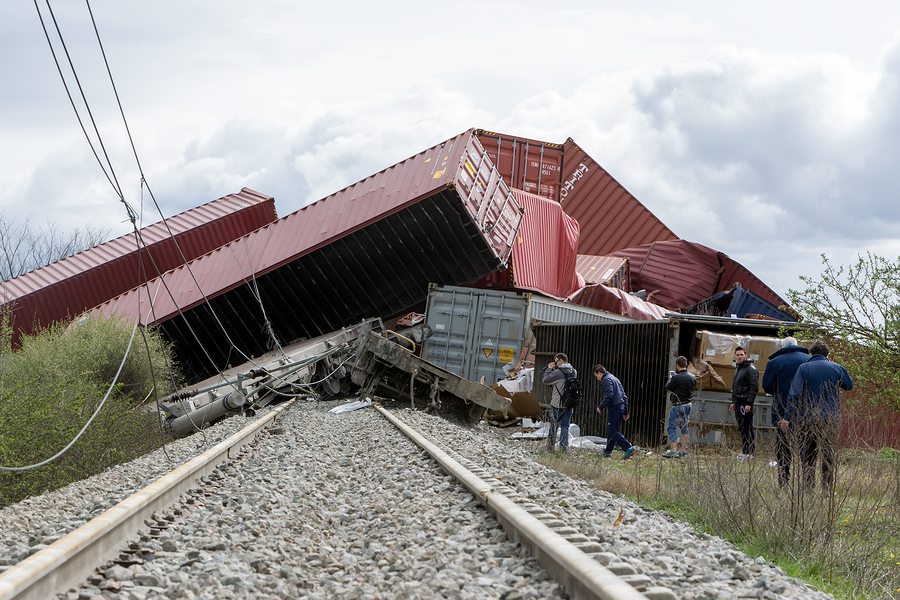According to the Federal Railroad Administration, in 2014 there were 11,896 train accidents at railroad crossings, resulting in 804 fatalities and thousands of injuries over the course of that year. There are a variety of reasons why these accidents occur. In the United States alone, we have over 600 separate and identified railroad lines, hundreds of thousands of miles of tracks, and more than 200,000 individual railroad crossings where tracks and roads intercept each other. While trains are not used as often as they were 20 years ago roads are becoming more and more crowded and trains are still a common method for hauling and shipping so there are still thousands of trains moving across the country each day. This gives plenty of opportunity for trains to get into accidents with each other and with vehicles crossing their paths.
Common Causes For Train Accidents
The common causes of train accidents include the following:
- Derailments– where the wheels slip or jump the track causing the cars to fall off the track
- Mechanical failure– some part of the trains system fails and causes an accident of some sort
- Human error– train engineer or the driver of a vehicle makes a mistake that leads to an accident
- Distracted pedestrians– foot traffic crossing train tracks that end up being hit by a passing train
- Problems with track– broken or damaged tracks often lead to a derailment or loss of control
- Collison– crashes where the train hits another train or some other type of vehicle on the road
- Unprotected crossings– small towns and remote areas don’t have crossing arms and lights
- Stalled cars– when cars stall on the tracks trains are unable to stop in time to avoid a collision
- Suicides– rarely some crashes are caused by someone stepping in front of the train intentionally
The details of a train accident are required to be made public once an investigation has been completed and all the data and details must be analyzed carefully so that authorities can properly determine fault and proper compensation and any changes to safety protocols that may be needed. In the Department of Transportation Act of 1966, the Federal Railroad Administration has been given the authority and also the responsibility to oversee and promote railway safety regulations. This is the department that gets involved when safety concerns are acknowledged and when changes to railway safety protocol and regulations are needed.
Who’s Responsible for Railway Safety
The Federal Railway Administration’s Office of Railroad Safety promotes and regulates safety throughout the Nation’s railroad industry. The office executes its regulatory and inspection responsibilities through a diverse staff of railroad safety experts. The staff includes 400 Federal safety inspectors who operate out of eight regional offices. Each regional administrator is supported by two deputy regional administrators, chief inspectors, supervisory specialists, grade crossing safety managers and safety inspectors for five of the safety disciplines focusing on compliance and enforcement in:
- Hazardous Materials
- Motive Power and Equipment
- Operating Practices
- Signal, Track and Train Control
- Railroad Safety and Customer Training
- Safety Inspections and Write-ups
- Fatality Investigations and Reporting
- Partnerships and Networking of Local Department
- Safety Standard Development and Enforcement
Train Accident Prevention
The best thing for everyone is to avoid the need for an attorney to represent you in an injury case in the first place. Here are tips for preventing train related accidents from happening:
- Never assume the track is not being used
- Never stop on a railroad track for any reason
- Never enter tunnels or bridges where you don’t have a way to escape an approaching train
- Never drive around gate arms and assume a train is not approaching
- Never walk down or play on a train track
- Never attempt to race with a train or beat a train to the crossing
- Always carefully check both ways before crossing a track that has no safety arm
- Remember trains are wider than the tracks so be sure to stop far enough back at a crossing
- Ensure hitches are high enough so your truck or trailer does not get stuck on track
- A train going 55 mph needs a mile minimum to stop
Contact Us
If you or a loved one has been injured due to a train accident, contact us today to see if you have a case and let us fight for your rights! The consultation is free, and we operate on a contingency basis, which means that if you do not win your case, you owe us nothing.
